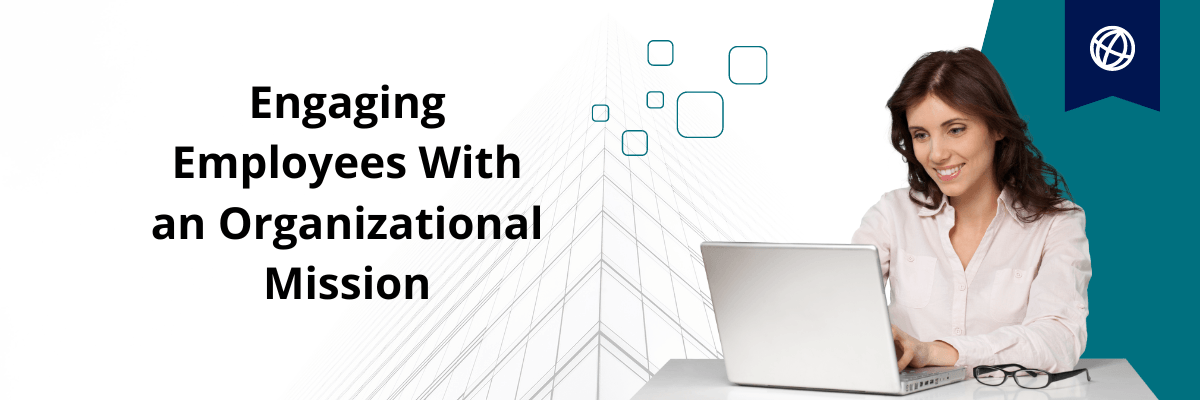
Organizations thrive through a sense of belonging and shared purpose. As employers navigate on-site, hybrid and remote work models, many may worry that those critical success factors could get lost in the workplace. Luckily, there are still ways for employers to promote their organizational mission with all employees, regardless of location. In times when employers may struggle to find and keep the workers they need, a strong and authentic organizational mission can help attract and retain top talent. Workers are more likely to be engaged and loyal to organizations with a mission they believe in and trust.
This article explores opportunities for employers to engage and unite their employees in both on-site and distributed workplaces.
A Mission Everyone Believes
According to Indeed.com, an organizational mission—or a mission statement—is a brief, broad statement about a company's goals and how it intends to meet them. It can address what the organization offers and how it hopes to serve its customers, community, employees, investors or other key stakeholders. Strong missions develop a human connection or an idea or behavior that employees can get behind and truly believe.
Cultural values are a way for the organization to achieve its mission. They define employee behavioral expectations and explain how leadership expects employees to work. Ultimately, everyone is working toward the same goal and demonstrating the values and behaviors aligned with and expected from the organization.
Connecting with Employees
It’s much easier to implement an employee engagement plan with a solid understanding of the organizational mission. Employers should consider the following tips to promote an organizational mission while keeping all employees engaged and firmly believing in the company:
- Involve employees early. The sooner organizations get the mission in front of employees, the sooner employees see how their role impacts the mission. The organizational mission and other company information are critical components of the onboarding process. This step reinforces that employees’ work does matter.
- Celebrate and communicate wins. Whether big or small, celebrating any organizational success that upholds the mission and delivers value to stakeholders not only reminds employees about how performance is measured, but demonstrates that those actions are important and truly make a difference.
- Reward behaviors that support company goals. Recognizing and rewarding employees who contribute to the progress and achievement of company goals is crucial. For example, encourage employees to share insight about what the mission means to them and how they live it. This can help provide concrete examples for other employees and demonstrate that the organization truly believes in and strives for that behavior or mindset. Recognition in a public format ensures that all employees are aware of the star behavior, which now comes to life in the workday.
- Foster belonging in the workplace. Many factors can contribute to employees’ sense of belonging in the workplace; however, a critical element revolves around whether employees are proud of their employer’s mission or purpose. When aligned with the mission, employees are often proud of their work and the organization.
- Continue organizational traditions. Everything that once drove formal and informal culture in the physical workplace needs to be reformatted to ensure inclusivity and connection between the physical and virtual workforces. This includes team-building activities, wellness initiatives, milestone celebrations and companywide events that allow employees to preserve or strengthen social attachments.
- Establish informal and formal engagement opportunities. Employers can encourage team leaders to create formal stand-up or check-in meetings to keep the team regularly connected. It’s equally important to support informal opportunities such as mentorship, walking meetings and coffee breaks. It’s all about encouraging and, to a certain extent, facilitating communication among employees.
- Drive employees to an intranet or other shared platform. It’s critical that all employees have access to the latest company happenings. For example, a company intranet can become a one-stop destination for employees to get to know each other and communicate. When there’s a designated destination for all updates, all employees receive the same information at the same time, and there’s no advantage of being on-site or remote. Additionally, communication apps and channels can serve as engaging employee channels and provide a shared platform for employees to stay in touch.
Lastly, employers should be intentional about communication by ensuring there’s a communication plan in place or, at a minimum, establishing guidelines about how the organization communicates and how frequently. Communication formats and other employee preferences should be taken into consideration to make sure organizational information and updates resonate with and engage the entire workforce.
If working situations have changed, it may be helpful for employers to ask employees about current challenges and opportunities for living out company values, whether formally through a survey or informally during department meetings. A baseline survey can help organizations identify disparities between the company’s mission and values and how employees actually feel about the company and workplace, and ultimately address such issues.
Summary
In a distributed work environment, the in-person work culture typically dominates, which could isolate employees working remotely full- or part-time. That means it’s imperative for employers to prioritize employee engagement in workplace strategies. Contact us today for more information on distributed workplace strategy and management.
Sign up for our newsletter.




